Haedal has redefined the staking experience with its innovative liquid staking solution.
Written by: Deep Tide TechFlow
In 2024, the DeFi sector of the Sui ecosystem has already shown remarkable growth. This momentum is expected to continue into 2025.
According to data from Defillama, in the first quarter of 2025, the TVL of the Sui ecosystem surpassed $2 billion, achieving a staggering 341% growth compared to the beginning of the fourth quarter of last year. The trading volume on DEXs within the ecosystem continues to rise, and user activity is reaching new highs. This series of impressive data not only confirms the market's confidence in the Sui network but also indicates that the Sui ecosystem will experience a new round of explosive growth in 2025.
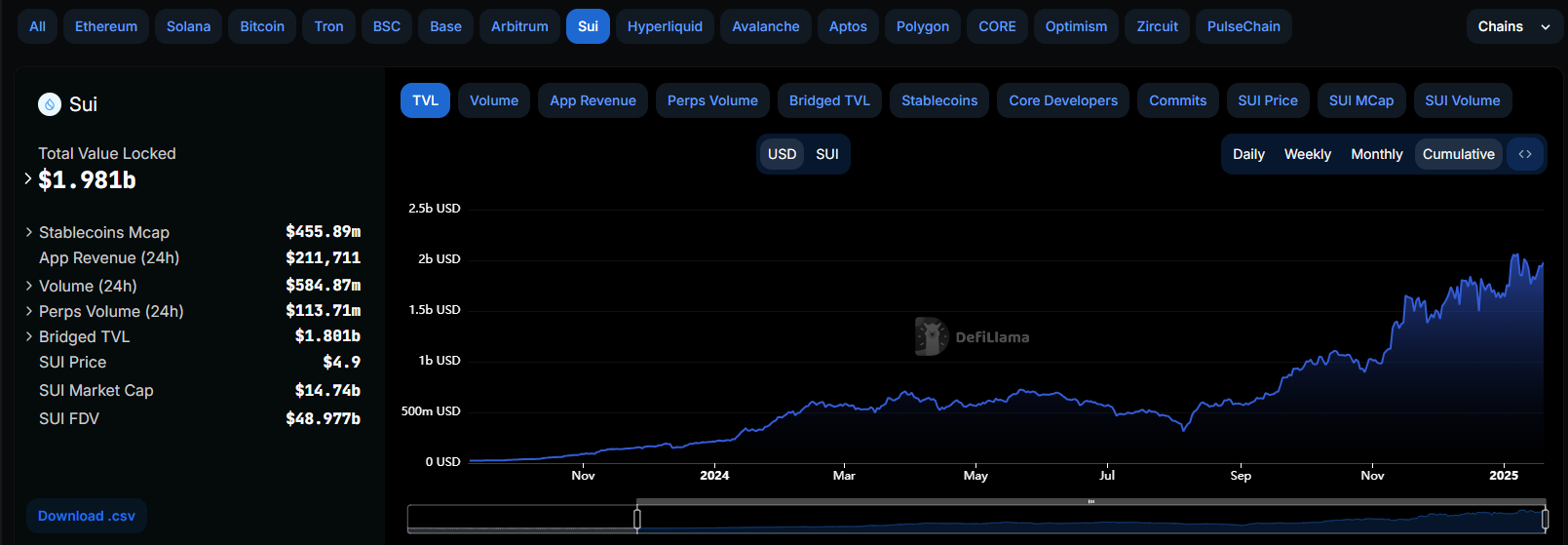
As the ecosystem takes off, the richness of applications and the user base are expanding simultaneously, leading to a geometric increase in the demand for staking SUI tokens.
However, Sui ecosystem users still have concerns about staking: one is how to balance liquidity and staking rewards, and the other is that compared to ETH and SOL, the current annualized staking yield for Sui is relatively low.
These unavoidable issues in Sui DeFi have become an excellent breakthrough point in the eyes of the Haedal team.
As a winning project of the Sui Liquid Staking Hackathon, Haedal has redefined the staking experience with its innovative liquid staking solution. After its launch, the project quickly gained market recognition, with TVL surpassing $188 million. Behind this achievement is Haedal's deep thinking in product design and technological innovation.
Haedal: From Dark Horse to Leader
In the thriving Sui ecosystem, Haedal is undoubtedly a standout in the DeFi field.
From the data, even in the current unfavorable market environment, Haedal maintains a TVL of $120 million, firmly holding the top position in the Sui network's LSD sector. Over $150 million of active liquidity is circulating on major DEXs and DeFi protocols with its issued liquid staking token haSUI.
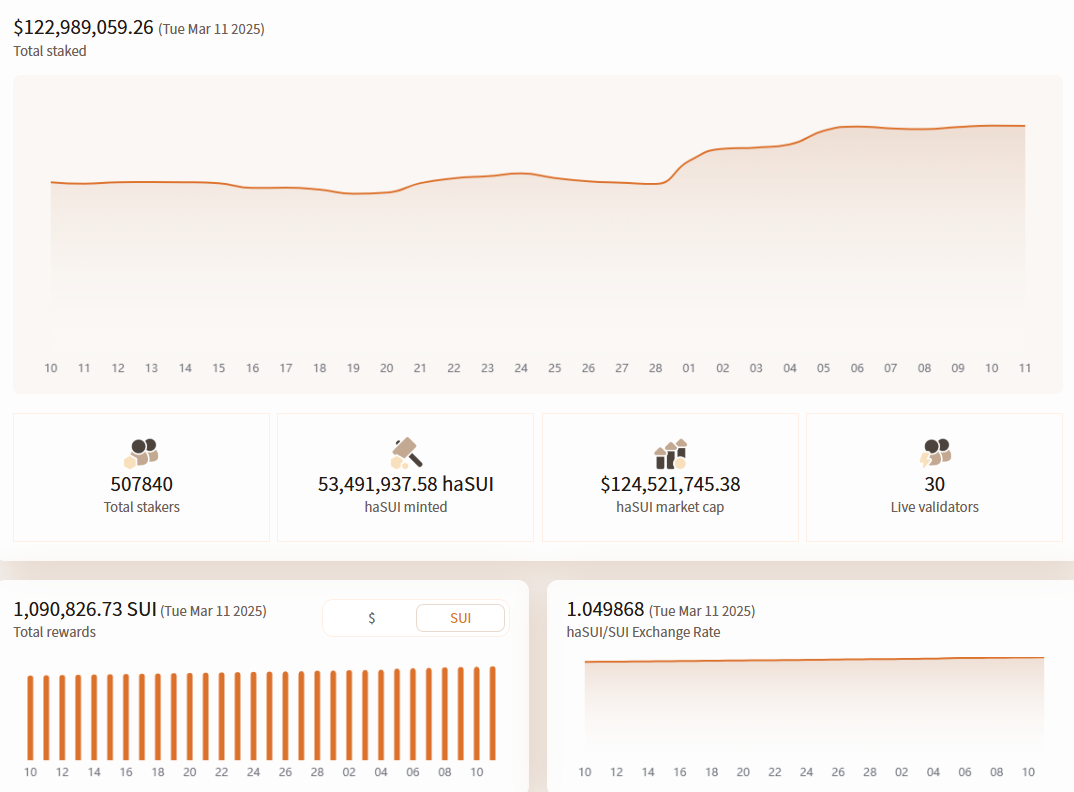
Through strategic partnerships with leading projects in the Sui ecosystem DeFi applications such as Cetus, Turbos, Navi, Scallop, and Mole, Haedal has built a highly collaborative DeFi ecosystem. haSUI has become one of the most active LST assets on these platforms, especially after the launch of Hae3, where the protocol achieves a win-win situation for users, partners, and the platform through an innovative revenue distribution mechanism.
In addition to focusing on returns, Haedal always places security and ecological sustainability at its core, employing a multi-signature mechanism and real-time risk monitoring system to ensure the safety of user assets, while also bringing in top security audit firms like Certik and SlowMist for regular reviews. As of March 2025, Haedal's smart contract system has passed five rounds of professional audits, handling over $1 billion in asset circulation with zero security incidents.
Multi-Dimensional Products to Enhance Sui Ecosystem Staking Returns
As mentioned earlier, the low staking returns in the Sui ecosystem have made many users indifferent to staking:
Currently, the average APR of LSTs in the Sui ecosystem is about 2.33%, while many validators' direct staking APRs do not even reach this figure.
In contrast, Lido's APR is about 3.1%, while Jito's APR reaches as high as 7.85%. For holders of Sui's native tokens, such returns are insufficient to incentivize them to move their tokens from centralized exchanges to the Sui on-chain environment.
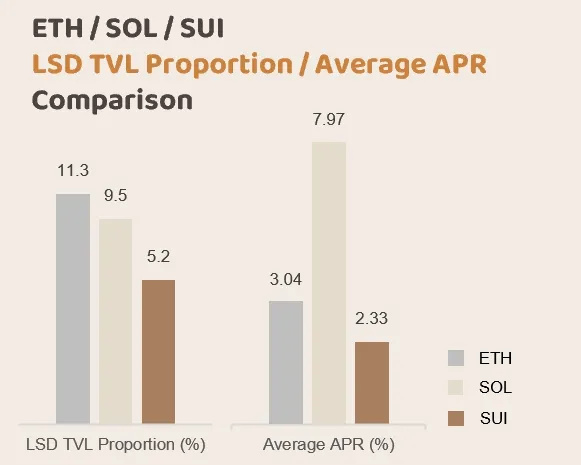
So how can we make Sui's staking more attractive? Haedal decided to tackle this from both "cost reduction" and "revenue increase."
First, regarding cost reduction, since most LSTs on Sui are based on validators, it means that each LST token is bound to a specific validator.
While this is not inherently problematic, it does not guarantee that the validator's APR is the highest. Additionally, most validators charge a commission of 4%-8%, further reducing the final APR of LSTs.
To address this phenomenon, Haedal offers a dynamic validator selection feature that continuously monitors the status of all validators on the network and selects the validator with the highest net APR during the staking process (these validators typically charge 0%-2% in commissions). Similarly, when users unstake, Haedal will choose the validator with the lowest APR for withdrawal. This dynamic approach ensures that haSUI always maintains the highest native APR across the ecosystem.
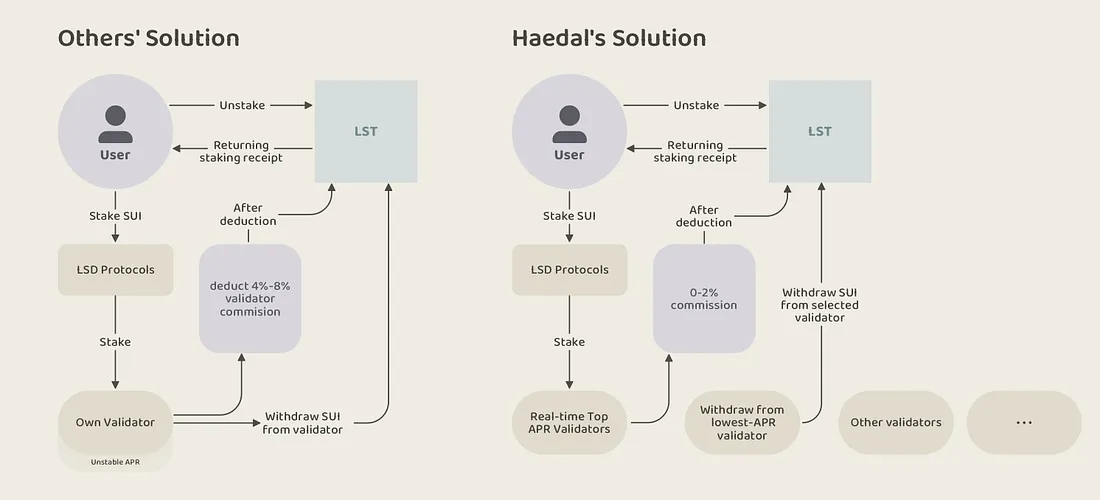
This cost-reduction improvement can achieve a higher APR to some extent, but it still cannot break through the fundamental system constraints—the MEV cost dilemma.
The Sui ecosystem views MEV as a product of DeFi's immaturity, and treating it as a fixed transaction cost could lead to on-chain transaction costs being ten to a hundred times higher than those of centralized exchanges, making it difficult to compete with centralized products. Moreover, the slippage costs brought by MEV can worsen the user experience.
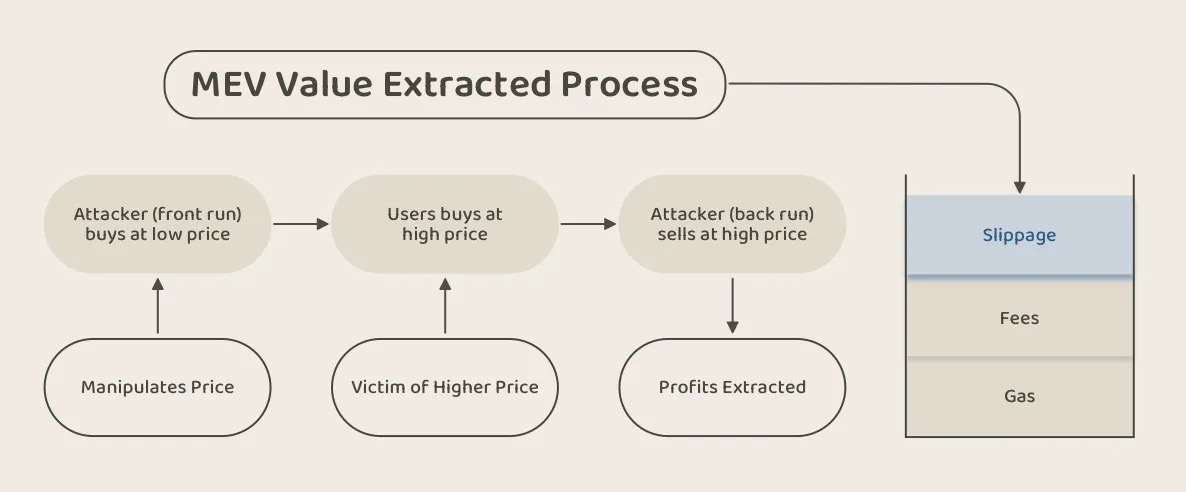
Image: Sandwich attacks severely impact transaction experience and outcomes.
As a result, Haedal has launched products that increase staking income from multiple angles: Hae3.
Hae3: Extracting Value from Ecological Trading Flow
Currently, most transactions on Sui are initiated through aggregators (as is the case in most ecosystems). After users initiate a transaction, various AMM DEXs (like Cetus) and CLOB DEXs (like Deepbook) provide quotes based on the status of liquidity pools or orders, and the routing system calculates the best path to complete the transaction.
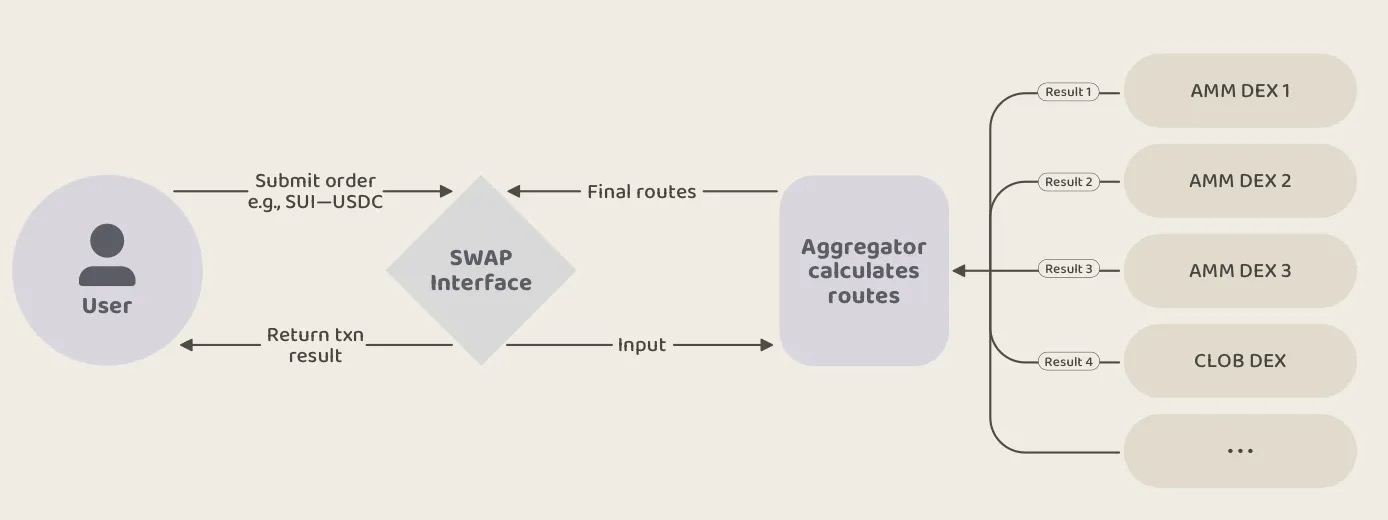
How can we provide users with additional income in this process while building a complete system? Hae3 offers two powerful yield-enhancing products, HMM and haeVault, along with a mature DAO community, haeDAO.
- ### HMM: Efficient Market Making, Boosting Returns
Trading has always been the purest and most classic profit model in the market. Haedal clearly understands this. Through the Haedal Market Maker (HMM) system, Haedal can open up new sources of income for staking users while ensuring basic staking returns.
HMM has the following three core functions:
Concentrated liquidity based on oracle pricing: Unlike other DEXs that determine prices based on the status of liquidity pools, HMM's prices are always based on oracle pricing. Oracles provide price updates at high frequency (every 0.25 seconds), ensuring that the liquidity in the aggregator remains consistent with the "fair market price."
Automatic rebalancing and market making: HMM's liquidity automatically rebalances based on the status of assets, capturing market fluctuations and using a "buy low, sell high" strategy, potentially turning impermanent loss into "impermanent gains."
Anti-MEV: HMM is inherently capable of defending against MEV attacks, ensuring that trading profits are not eroded by front-running or sandwich attacks.

After two months of testing, HMM has captured about 10-15% of the total DEX trading volume, and the APR of haSUI has steadily increased, currently stabilizing at 3.5%, far exceeding other LSTs on Sui. Among these, HMM has contributed an additional 0.92% APR to haSUI.
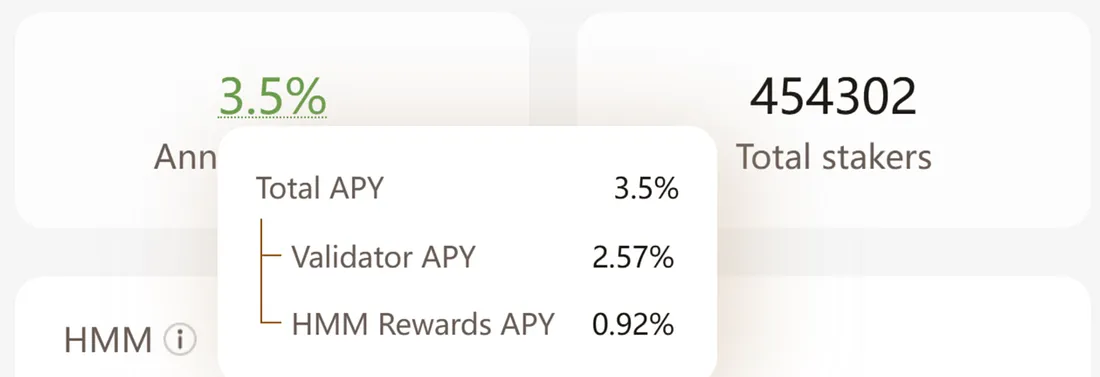
- ### haeVault: Enabling Ordinary Users to Access Professional Market Making Returns
In addition to extracting value from various segments, Haedal also provides an additional income path for ordinary users: professional on-chain LP.
Liquidity providers (LPs) are certainly familiar to users who are well-versed in on-chain operations. Adding liquidity to popular trading pairs is also a basic operation for on-chain experts.
However, for many ordinary users, the threshold to become an LP is too high. In the currently most commonly used CLAMM algorithm on Sui, if a user wants to provide liquidity for the SUI-USDC pool, they need to handle the following complex matters:
Deciding the price range: Users need to make subjective judgments about the price range.
Adjusting liquidity: Dynamically adjusting liquidity based on the set price range.
Monitoring position status: Continuously checking whether their liquidity is "out of range."
Deciding whether to rebalance: Judging whether to perform rebalancing operations on their position.
This entire process is neither intuitive nor efficient. Moreover, various potential unexpected situations, such as impermanent loss, deter many from investing large amounts of capital, or they may only provide liquidity within very conservative price ranges, which naturally prevents them from capturing the maximum LP returns.
In comparison, the average APR for the SUI-USDC pool on Sui is approximately 150%, while liquidity providers in full-range or ultra-wide ranges may only achieve an APR of 10%-20%. Some users even pursue low or zero impermanent loss risks more obsessively, leading them to prefer lending or staking, which typically offer single-digit APRs.
Professional on-chain LPs, by simulating market-making strategies from centralized exchanges (CEX), usually provide liquidity within ultra-narrow ranges and utilize self-built monitoring bots and programs to execute rebalancing and capital hedging operations, earning relatively high returns compared to ordinary users.
In response, haeVault offers a method that allows ordinary users to easily participate in liquidity provision and enjoy revenue strategies similar to professional market makers.
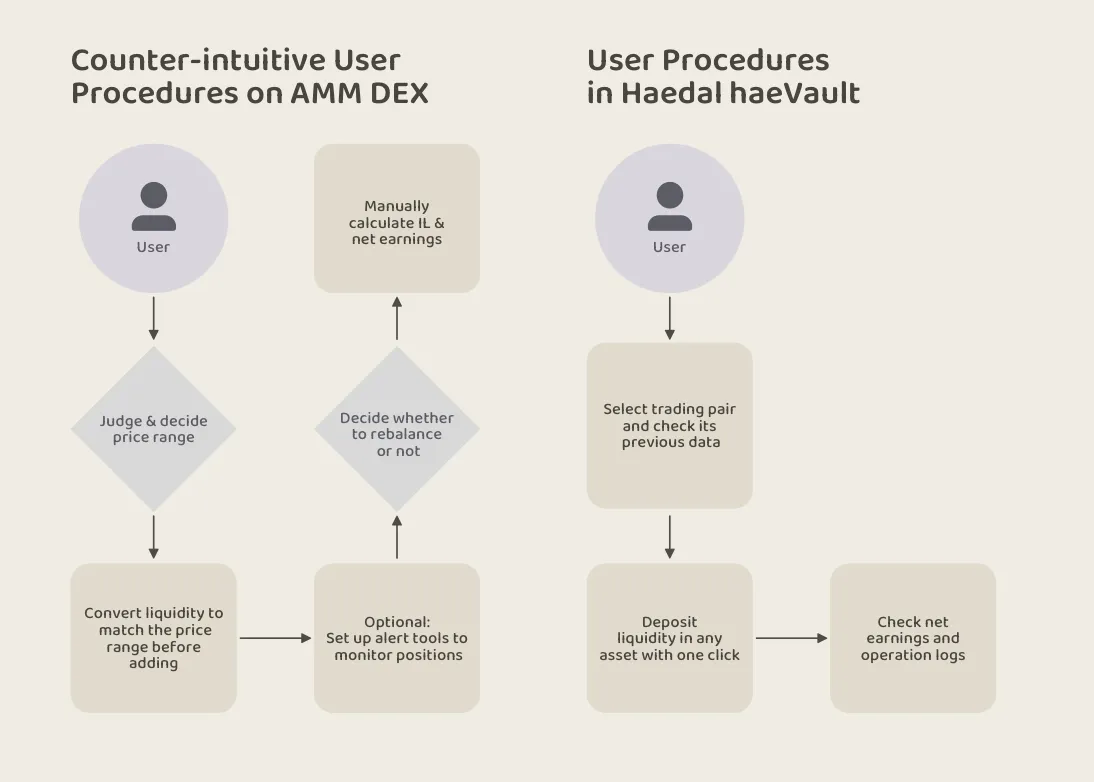
haeVault is built on AMM DEX and features an automated liquidity management layer. It can automatically adjust liquidity based on token price fluctuations and rebalance positions based on key indicators. haeVault is designed with professional strategies similar to CEX market makers for DEX LP users. The difference is that CEX market makers profit through "buy low, sell high," while haeVault continuously earns revenue from the trading fee income generated by its active liquidity on DEX.
Core features of haeVault:
User-friendly operation: Users can participate by depositing any asset with a single click.
Transparency: Users can clearly view their profits and losses.
Fully automated management: Users do not need to perform any other operations aside from deposit and withdrawal.
High returns: With the help of professional strategies, users will achieve more competitive returns compared to other LPs.
Unlike HMM, haeVault will be directly open to all users, and its design is inherently suitable for attracting large amounts of capital. Once haeVault accumulates sufficient TVL, it has the potential to capture significant trading fee income from mainstream assets on DEX.
Currently, Haedal plans to launch the Alpha version of haeVault in the coming weeks, so stay tuned.
- ### haeDAO: Community and Protocol Self-Controlled Liquidity
With the continuous growth of TVL for the two core products, HMM and haeVault, it is foreseeable that the Hae3 system will capture a large amount of trading fee income within the Sui ecosystem.
Regarding revenue distribution, Hae3 also has plans:
50%: To enhance the APR of Haedal LSTs.
10%: Allocated to the team to ensure the long-term sustainability of the protocol.
40%: Allocated to the Haedal treasury as the protocol's own liquidity.
In the initial phase, treasury funds will be reinvested into Haedal's products to expand liquidity. As the products mature, Haedal will introduce HaeDAO to manage the treasury, empowering Haedal tokens and the community.

Haedal token $HAEDAL can be locked to obtain veHAEDAL (tentative name), which grants all rights within haeDAO. These rights include:
Management of the Haedal treasury: Deciding the asset allocation of the treasury, liquidity distribution among different product modules or protocols, reward distribution methods, etc.
Enhancing haeVault returns: Users' weights in haeVault can be increased to enjoy higher annualized returns.
Proposals and voting: Major decisions of the protocol will be made through DAO voting, such as key product directions and treasury usage.
HaeDAO is expected to launch in the second quarter of 2025, becoming the final piece to complete the Hae3 product suite. As the Hae3 economic system gradually grows into a sustainable and expanding treasury, the Haedal ecosystem will also achieve long-term sustainable development and growth.
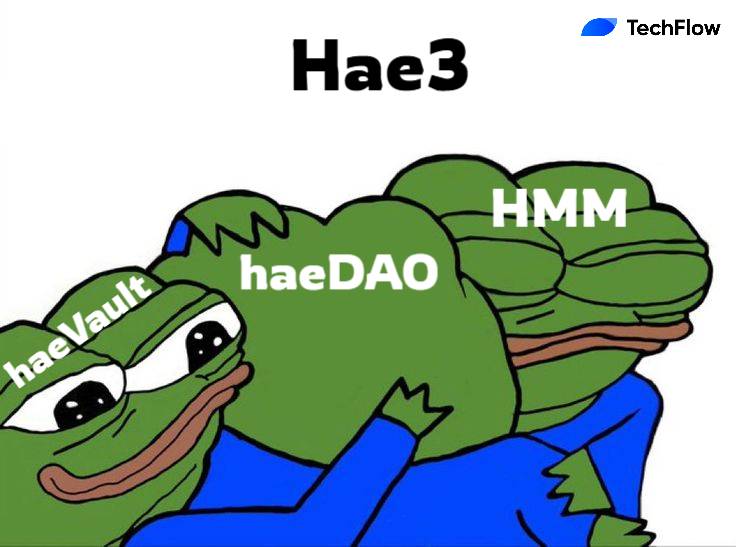
From "Efficiency" to "Ecology"
From initially focusing on liquid staking products to now having built a complete liquid staking product matrix that includes Hae3, Haedal has consistently responded to market demands with technological innovation.
As the core product matrix matures, Haedal's development will enter a new phase. In this phase, how to balance product innovation with user experience, and how to deepen ecological cooperation while maintaining technological leadership, will be new challenges for the team. The market will continue to pay attention to Haedal's performance in the face of these new challenges.
免责声明:本文章仅代表作者个人观点,不代表本平台的立场和观点。本文章仅供信息分享,不构成对任何人的任何投资建议。用户与作者之间的任何争议,与本平台无关。如网页中刊载的文章或图片涉及侵权,请提供相关的权利证明和身份证明发送邮件到support@aicoin.com,本平台相关工作人员将会进行核查。




